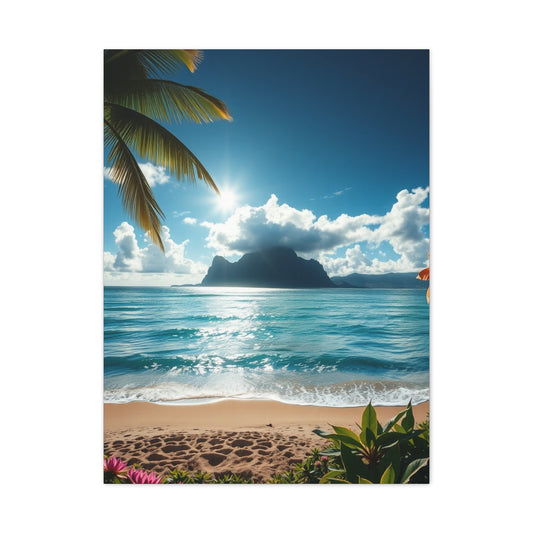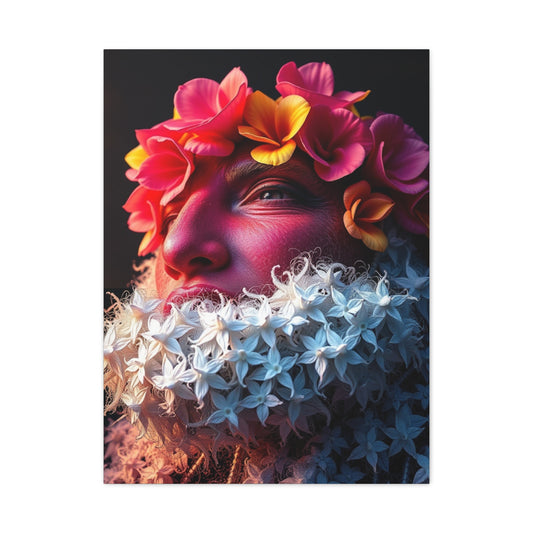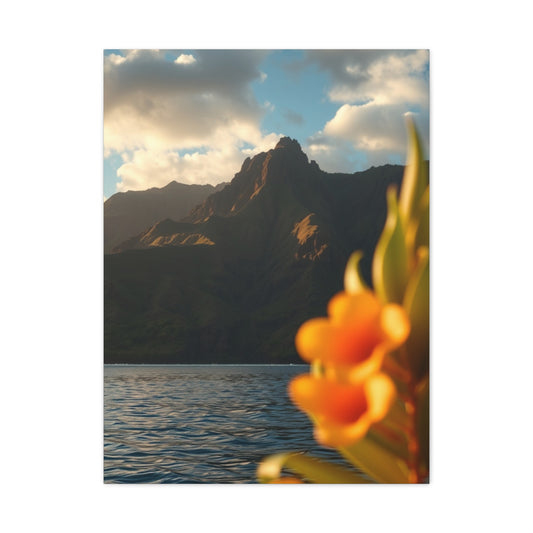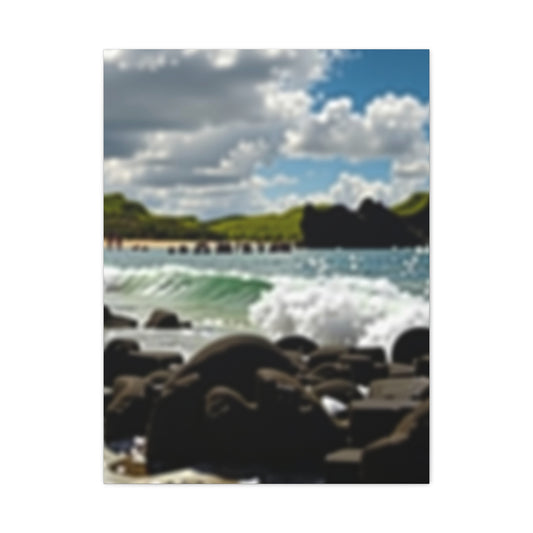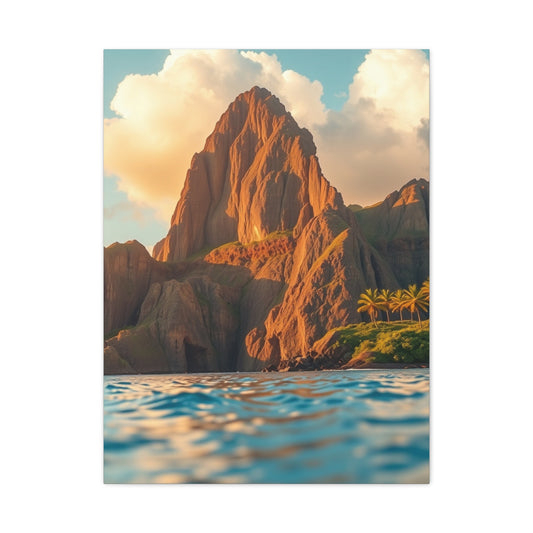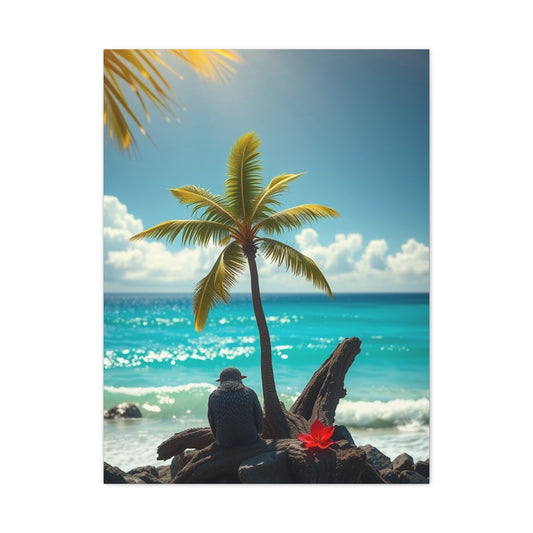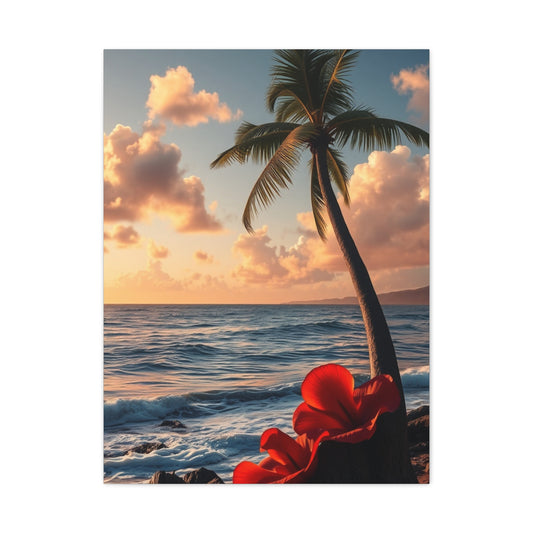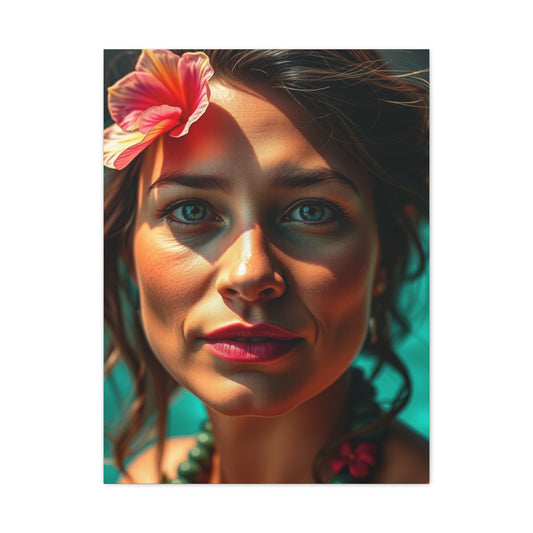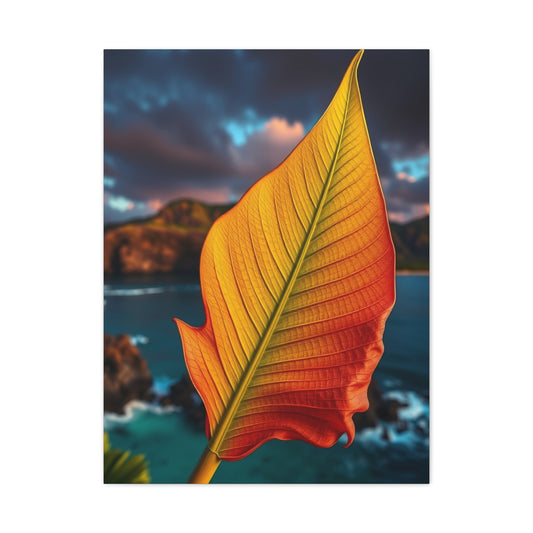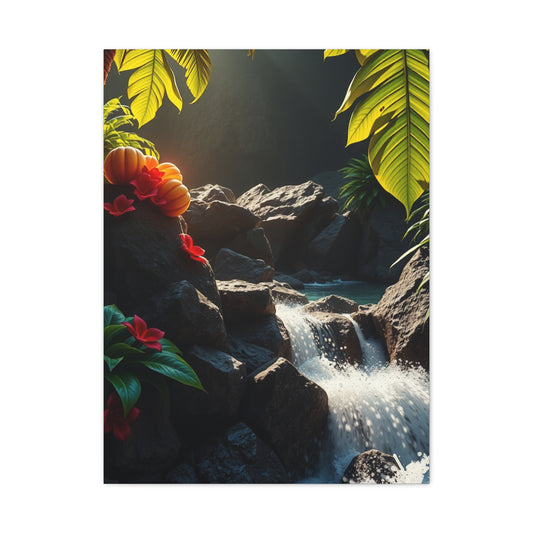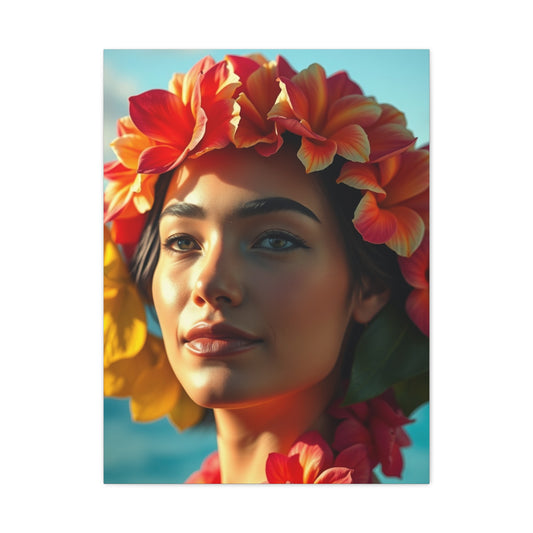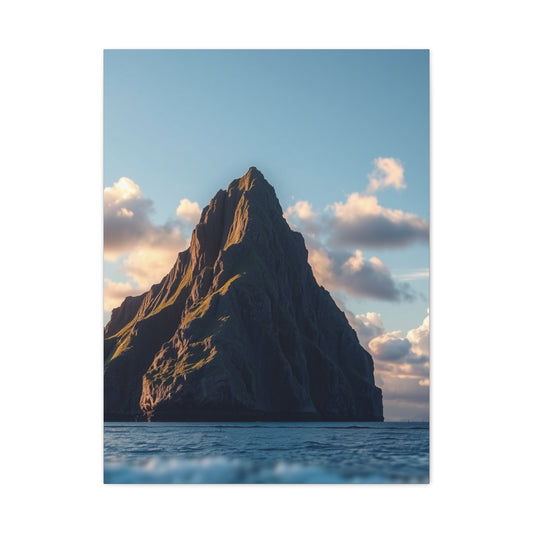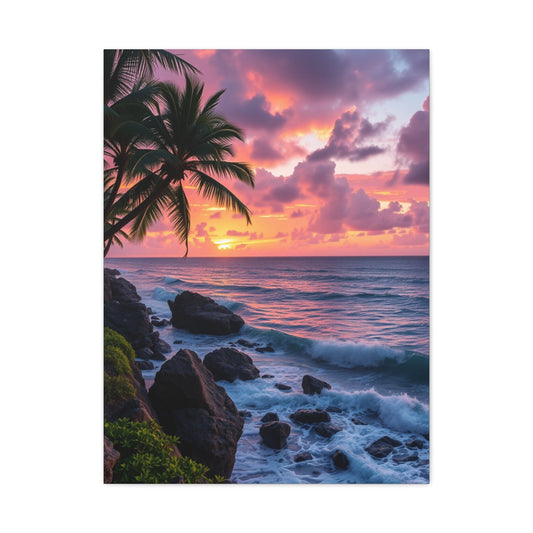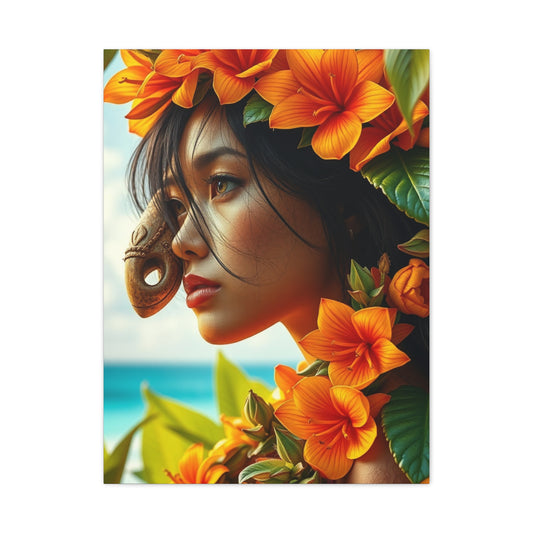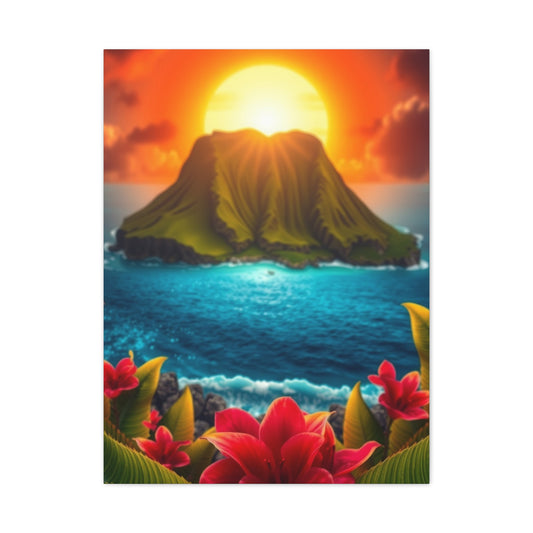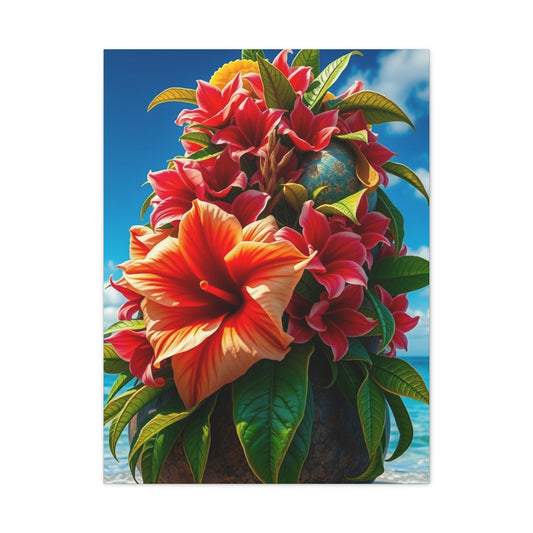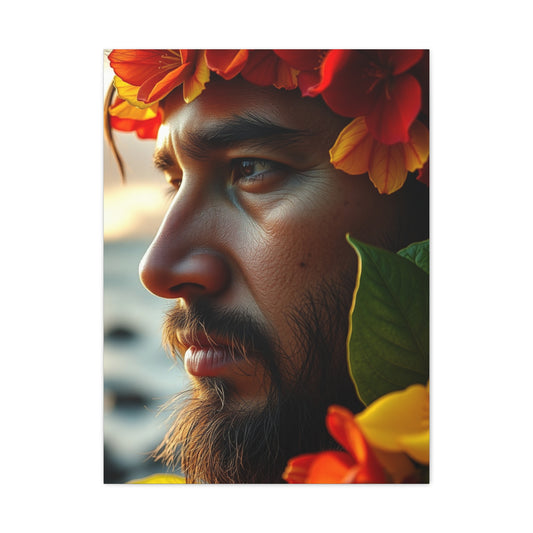Transform Your Living Space with Hawaii Wall Art and Tropical Vibes
Hawaiian wall art decor is more than just a decorative choice; it is a conduit to the serene landscapes, vivid sunsets, and lush tropics of the Hawaiian islands. These artistic creations capture the ethereal charm of island life, offering a way to transport the essence of Hawaii into everyday interiors. The visual narratives embedded within Hawaiian wall art often feature sweeping ocean views, verdant rainforests, and traditional motifs that echo centuries-old cultural stories. This decor can infuse any space with tranquility, vitality, and a sense of connection to nature, making it an appealing option for those seeking to transform their living spaces into personal sanctuaries.
The origins of Hawaiian art are deeply intertwined with the islands' history and indigenous traditions. Ancient Hawaiian visual culture was expressed through patterns and symbols that narrated myths, genealogies, and spiritual beliefs. These motifs, often geometric or inspired by natural forms, have persisted through time and found their way into modern decor. Incorporating such elements into contemporary interiors not only enriches the aesthetic experience but also fosters a deeper appreciation of Hawaii’s cultural heritage. Today’s Hawaiian wall art celebrates this lineage while integrating modern mediums, including canvas prints, framed photographs, and handcrafted wooden pieces, each conveying unique textures and emotional resonance.
The allure of Hawaiian wall art extends beyond mere decoration. These pieces offer an immersive experience that evokes the gentle sway of palm trees, the rhythmic cadence of waves against volcanic shores, and the fragrant perfume of tropical blossoms. By integrating these elements into indoor environments, homeowners can cultivate spaces that resonate with the concept of Aloha—a philosophy rooted in harmony, compassion, and the interconnection of all living things. Whether positioned in a vibrant living room or a quiet home office, Hawaiian-inspired artwork creates an atmosphere of contemplation and rejuvenation.
A distinguishing feature of Hawaiian wall art is its ability to marry vivid imagery with subtle nuances. The chromatic vibrancy of ocean blues, sunset ambers, and lush greens can energize a room, while softer hues and understated patterns offer a serene, almost meditative ambiance. This duality allows homeowners to tailor their interior spaces according to the desired emotional effect, whether aiming for spirited exuberance or tranquil retreat. The selection process, therefore, becomes an intimate exploration of both aesthetic preference and psychological resonance, reflecting the transformative power of art in everyday life.
Hawaiian wall art also serves as a focal point that anchors interior design schemes. Large-scale canvases depicting dramatic coastal panoramas can dominate a living room, drawing the eye and establishing a central theme around which complementary decor can be orchestrated. Smaller pieces, such as framed botanical studies or abstracted island patterns, can populate secondary walls, creating a layered visual dialogue. This interplay of scale and perspective contributes to a cohesive, immersive environment where each element enhances the overall narrative of tropical serenity.
The versatility of Hawaiian wall art allows it to adapt seamlessly across diverse interior styles. In minimalist spaces, a singular vibrant canvas can introduce a burst of color and narrative complexity without overwhelming the room. In contrast, eclectic or bohemian interiors benefit from a tapestry of varied pieces, combining handcrafted motifs with photographic realism to create a rich visual tapestry. Even in contemporary or industrial designs, the organic textures, flowing forms, and natural imagery characteristic of Hawaiian art can soften rigid architectural lines, imparting warmth and emotional resonance.
When exploring Hawaiian wall art, attention to materiality enhances both aesthetic and tactile experience. Canvas prints, for example, provide a matte, textured surface that absorbs light and emphasizes color depth, while framed photographs capture sharp detail and vibrant saturation. Handcrafted wooden panels offer a three-dimensional quality, allowing shadows and grain patterns to contribute to the artwork’s narrative. The tactile interaction with these materials can amplify the sense of presence and connection, transforming passive observation into a multisensory engagement with the islands’ spirit.
Cultural symbolism within Hawaiian art also plays a significant role in interior storytelling. Iconography such as the honu (sea turtle), plumeria flowers, or traditional kapa patterns imbue spaces with layered meaning. The honu, representing longevity and endurance, can serve as a meditative motif in a study or reading nook, while plumeria blossoms evoke beauty, grace, and the transience of life. Integrating such symbolic elements allows homeowners to craft spaces that are not only visually compelling but also imbued with narrative depth, enhancing the experiential quality of interior environments.
Light and spatial arrangement further influence the impact of Hawaiian wall art. Strategic placement near natural light sources can highlight textures, colors, and intricate details, allowing the art to evolve visually throughout the day. In rooms with subdued lighting, strategic spotlighting can replicate sunlight, emphasizing the artwork’s vibrancy and creating a dynamic interplay of shadow and luminosity. Additionally, thoughtful spacing between pieces allows each element to breathe, ensuring that the visual narrative unfolds harmoniously rather than feeling congested or chaotic.
Hawaiian wall art also encourages mindfulness and environmental appreciation. By bringing depictions of natural landscapes into everyday life, it fosters a sense of ecological consciousness and a reminder of the delicate beauty inherent in tropical ecosystems. This connection to nature can cultivate calmness, inspire creativity, and even support mental well-being, demonstrating how thoughtful decor choices extend beyond aesthetics to influence holistic living experiences.
In contemporary applications, Hawaiian wall art transcends traditional portrayals of islands and beaches. Abstract interpretations, experimental textures, and mixed-media creations reinterpret Hawaiian themes in novel ways, challenging conventional perspectives and inviting personal reflection. These contemporary approaches maintain cultural resonance while offering a fresh lens through which to experience island life, ensuring that Hawaiian wall art remains relevant and evocative across generations of interior design enthusiasts.
Ultimately, integrating Hawaiian wall art into home interiors is an act of storytelling, aesthetic curation, and emotional resonance. It invites inhabitants and visitors alike to experience the subtle rhythms of island life, from the gentle ebb of the tide to the vibrancy of tropical flora. Through careful selection, thoughtful placement, and mindful interaction with these artistic expressions, spaces can be transformed into sanctuaries that celebrate both natural beauty and cultural heritage.
The enduring appeal of Hawaiian wall art lies in its capacity to blend vibrancy and tranquility, tradition and modernity, narrative depth and visual delight. Each piece serves as a portal to the islands, evoking the spirit of Aloha while enriching interior spaces with sophistication and warmth. By embracing these artworks, homeowners can cultivate environments that not only delight the senses but also nurture the soul, establishing a lasting connection to the enchanting landscapes, cultural richness, and timeless serenity of Hawaii.
Choosing the Perfect Hawaiian Wall Art
Selecting the ideal Hawaiian wall art for your home is both an aesthetic pursuit and a deeply personal endeavor. The process involves more than simply choosing visually appealing pieces; it requires a careful consideration of color, composition, materiality, scale, and the emotional ambiance you wish to cultivate. The diverse landscapes, oceanic vistas, and cultural motifs inherent in Hawaiian art provide an expansive palette for interior expression, allowing every space to resonate with the serene vibrancy of the islands.
Understanding the Atmosphere
When deciding on Hawaiian wall art, the atmosphere you wish to evoke should be at the forefront. Art featuring radiant, tropical hues can infuse a room with exuberance, energizing spaces with a lively, almost celebratory essence. Conversely, pieces rendered in muted pastels or soft earth tones cultivate calmness, creating an oasis of repose that encourages reflection and mindfulness. Coastal panoramas, depicting the sun dipping below the horizon or waves caressing volcanic shores, naturally impart tranquility, while lush rainforest compositions brimming with vivid foliage evoke vitality and renewal. Determining the desired emotional resonance guides the selection of artwork, ensuring that the chosen pieces harmonize with the intended ambiance of each room.
Harmonizing with Existing Color Palettes
Hawaiian wall art thrives when thoughtfully integrated into a room’s existing color scheme. Rooms dominated by neutral tones can benefit from art that introduces rich, tropical colors, providing focal points that draw the eye and invigorate the space. Similarly, interiors with vibrant furnishings or textiles may call for art in complementary or subdued hues to maintain equilibrium and avoid visual discord. Paying attention to undertones, saturation, and contrasts ensures that each piece contributes to a cohesive visual narrative, enhancing the overall harmony of the interior environment.
Exploring Material Choices
The medium of Hawaiian wall art significantly influences its texture, luminosity, and presence within a space. Canvas prints are prized for their ability to absorb light and convey depth, creating a tactile richness that enhances the perception of color and detail. Framed photographic prints, on the other hand, offer precision and clarity, allowing the intricate features of Hawaiian flora, fauna, and seascapes to emerge vividly. Handcrafted wooden panels, often etched or carved with traditional motifs, contribute a sculptural dimension, where the grain and natural imperfections of the wood imbue the artwork with warmth and authenticity. The choice of material not only affects visual impact but also shapes the interaction between viewer and piece, adding layers of sensory engagement to the décor.
Considering Scale and Proportion
Scale is a critical factor in the selection of Hawaiian wall art. Large canvases depicting panoramic coastlines or expansive skies can serve as commanding focal points, anchoring living rooms, dining areas, or entryways with a sense of drama and immersion. Smaller pieces, such as botanical studies or abstract interpretations of oceanic forms, function as accent elements, creating rhythm and visual interest across secondary walls or intimate spaces. Achieving balance between large and small elements fosters a cohesive composition, allowing the eye to flow naturally from one piece to another without overwhelming the observer.
Curating Styles and Themes
Hawaiian wall art encompasses a range of stylistic approaches, each contributing a unique interpretive lens on island life. Realistic depictions capture the tangible beauty of beaches, mountains, and flora, creating an almost photographic immersion in the landscape. Abstract interpretations distill forms, colors, and textures into symbolic representations, offering viewers an emotional and contemplative engagement with the essence of the islands. Handcrafted works often integrate indigenous motifs, such as geometric kapa patterns, honu (turtle) iconography, or plumeria flowers, conveying cultural depth and narrative resonance. Curating pieces from these various styles allows for a multidimensional interior narrative, blending realism, abstraction, and tradition.
Integrating Cultural Symbolism
Beyond aesthetic appeal, Hawaiian wall art carries layers of cultural significance. Motifs such as the honu symbolize longevity, wisdom, and perseverance, while tropical flowers like hibiscus or plumeria evoke grace, beauty, and transient serenity. Incorporating these symbols into your decor imbues spaces with meaning, transforming walls from mere surfaces into storytelling canvases. Thoughtful selection of culturally resonant motifs can enhance the spiritual and emotional ambiance of a room, connecting inhabitants to the islands’ rich heritage and natural rhythms.
Balancing Multiple Pieces
When designing a collection of Hawaiian wall art, balance is essential. Mixing various sizes, materials, and thematic elements creates visual interest and prevents monotony. Large statement pieces can anchor a room, while smaller works can articulate details and provide contrast. Consider the rhythm and spacing between artworks, ensuring that each piece has room to breathe and that the overall arrangement feels deliberate rather than cluttered. Layering multiple works in a harmonious sequence allows each element to complement the others, contributing to an immersive and aesthetically satisfying environment.
The Role of Texture
Texture in Hawaiian wall art enhances its depth and sensory presence. Canvas surfaces offer a subtle tactile quality that interacts with natural light, creating shifting nuances throughout the day. Wooden carvings and handcrafted panels provide three-dimensional texture, allowing shadows and grain patterns to contribute to the narrative. Even photographic prints can introduce a perceived textural element, particularly when depicting natural subjects like rough volcanic rocks, rippling water, or dense foliage. Selecting artworks with varying textures enriches the visual and physical experience of the room, engaging the senses beyond sight alone.
Emphasizing Focal Points
Identifying focal points within a space helps determine the placement and selection of Hawaiian wall art. A large canvas depicting a sunset over the ocean can serve as the centerpiece of a living room, establishing a thematic anchor for the surrounding decor. Secondary pieces, such as framed botanical studies or abstract island-inspired patterns, can be arranged around this central focus to enhance cohesion and visual flow. Focal points draw the observer’s attention, creating a sense of narrative progression across the room and allowing the walls to convey a layered story of island beauty and cultural resonance.
Harmonizing with Interior Style
Hawaiian wall art demonstrates remarkable adaptability across diverse interior styles. Minimalist interiors can benefit from a singular vibrant piece that introduces color and emotional depth without overwhelming simplicity. Bohemian or eclectic spaces thrive when multiple works—handcrafted, photographic, and abstract—interact in a tapestry of visual richness. Even modern or industrial interiors can incorporate Hawaiian elements, where organic textures, flowing forms, and natural imagery soften angular lines and introduce warmth. By understanding how the artwork aligns with the broader interior style, homeowners can achieve harmony while retaining the distinct essence of tropical decor.
Layering and Complementary Elements
The impact of Hawaiian wall art can be amplified through thoughtful layering with complementary decor. Textiles, such as throw pillows or area rugs with subtle island-inspired patterns, reinforce the visual narrative without overpowering the walls. Incorporating tropical plants, from small potted palms to larger indoor trees, extends the natural motifs of the artwork into three-dimensional space. This approach creates a seamless integration of art and environment, enhancing the immersive quality of the interior and fostering a sense of living within the tropical landscape itself.
Seasonal and Lighting Considerations
Lighting and seasonality play significant roles in selecting Hawaiian wall art. Pieces with vibrant blues, greens, and golds can appear even more luminous when placed near natural light sources, while softer tones provide calmness in spaces with subdued illumination. Considering the way light interacts with textures and colors ensures that the artwork maintains its intended emotional impact throughout the day. Seasonal adjustments, such as rotating art to highlight warm, fiery tones in autumn or cooler, tranquil palettes in summer, can further enrich the connection between interior spaces and natural rhythms.
The Emotional Connection
Ultimately, the perfect Hawaiian wall art resonates on a personal level. Beyond composition, color, and material, it must evoke an emotional response—whether that is a sense of peace, a spark of inspiration, or a joyful reminder of the islands’ splendor. Selecting artwork that aligns with personal experiences, memories, or aspirations strengthens the connection between the inhabitant and the space. This emotional resonance transforms walls from static surfaces into dynamic, narrative-rich environments that reflect individuality while celebrating the timeless beauty of Hawaii.
Techniques for Hanging and Arranging Hawaiian Wall Art
The display of Hawaiian wall art is a vital aspect of interior design, as the arrangement and placement can dramatically influence the ambiance of a space. Properly hung art elevates both the aesthetic appeal and the narrative resonance of a room, allowing the tropical vibrancy, oceanic vistas, and cultural motifs to be fully appreciated. Achieving a balanced, visually captivating arrangement involves careful attention to scale, proportion, composition, and spatial dynamics.
Understanding Wall Space
Before selecting or positioning artwork, it is crucial to assess the available wall space. Measuring the dimensions of a wall ensures that the chosen pieces harmonize with the architectural proportions and do not overwhelm or underwhelm the space. Larger canvases depicting expansive ocean views or sunset panoramas often serve as focal anchors, while smaller works can complement these main pieces by filling negative space and establishing visual rhythm. Attention to wall height, furniture placement, and natural light sources informs the optimal positioning of each piece.
Eye-Level Placement
A fundamental principle in displaying Hawaiian wall art is to align the center of the artwork at approximately eye level. This typically falls between 57 and 60 inches from the floor, allowing the viewer to engage with the art naturally and comfortably. Maintaining consistent eye-level alignment across multiple pieces creates cohesion, particularly in spaces featuring multiple artworks. This approach ensures that the viewer’s gaze flows organically across the room, enhancing the immersive quality of tropical decor.
Arranging Multiple Pieces
When incorporating several pieces of Hawaiian wall art, balance and rhythm become essential. Mixing large and small artworks adds visual interest, while maintaining a coherent thematic or color-based connection ensures harmony. Larger statement pieces often function as anchors, while smaller pieces, such as framed botanical studies or abstracted island motifs, provide supporting narratives. The interplay between varying dimensions, shapes, and textures fosters dynamic compositions that evoke the multifaceted beauty of the Hawaiian islands.
Gallery Wall Layouts
Gallery wall arrangements are an effective method for showcasing multiple Hawaiian artworks in a cohesive and visually stimulating manner. These layouts can take the form of grids, symmetrical patterns, or more freeform arrangements. Grid configurations emphasize order and structure, ideal for minimalistic or contemporary interiors. Freeform arrangements, by contrast, offer a more organic, eclectic feel, mirroring the natural irregularities of tropical landscapes. Prior to committing to nails or hooks, it is beneficial to lay out the pieces on the floor, experimenting with spacing and alignment to identify the most compelling composition.
Balancing Shapes and Styles
Combining different shapes and styles enhances the visual complexity of a gallery wall or multi-piece display. Rectangular canvases depicting ocean horizons can be paired with square or circular prints featuring floral patterns or cultural motifs. Integrating abstract interpretations alongside realistic depictions adds layers of narrative and emotional resonance. Maintaining a deliberate balance between styles ensures that no single element dominates or diminishes the impact of the others, creating a harmonious visual dialogue across the wall.
Spacing and Visual Breathing Room
Negative space, or the areas between artworks, plays a crucial role in allowing Hawaiian wall art to breathe and be appreciated individually. Adequate spacing prevents visual clutter and guides the eye through the display naturally. Spacing considerations should account for the scale of the artwork and the wall, as well as the proximity of furniture or architectural elements. The judicious use of negative space enhances both the aesthetic impact and the contemplative quality of the room, reinforcing the serene ambiance associated with tropical decor.
Layering and Depth
Layering is an advanced technique that introduces depth and dimension to Hawaiian wall art arrangements. Overlapping frames slightly or combining two-dimensional prints with three-dimensional handcrafted panels adds tactile and visual richness. This method creates a sense of continuity and immersion, allowing viewers to experience the artwork as a multidimensional landscape. Layering mirrors the layered complexity of Hawaiian nature itself, from the dense forests to the undulating ocean waves, bringing an element of realism and dynamism to interior spaces.
Lighting Considerations
Lighting is pivotal in showcasing Hawaiian wall art. Natural light can accentuate textures, illuminate colors, and create subtle changes in mood throughout the day. For spaces with limited natural light, strategically positioned accent lighting, such as picture lights or adjustable spotlights, enhances the vibrancy of colors and highlights intricate details. Warm lighting complements tropical tones, evoking the golden glow of sunsets, while cooler lighting can accentuate blues and greens, reminiscent of ocean vistas and lush foliage. Thoughtful lighting elevates the artwork’s visual impact and reinforces the desired atmosphere.
Anchoring Artwork with Furniture
Positioning Hawaiian wall art in relation to furniture enhances spatial harmony. Large canvases work well above sofas, consoles, or beds, establishing a central visual narrative. Smaller works can be positioned above side tables, shelving units, or mantels, providing complementary points of interest. Aligning artwork with furniture edges, rather than centering arbitrarily on the wall, ensures visual coherence and reinforces the structural rhythm of the room. This technique integrates the art organically into the living environment rather than isolating it as a detached object.
Incorporating Texture and Materiality
Texture is a vital consideration in arranging Hawaiian wall art. Canvas pieces with subtle grain, handcrafted wooden panels, or layered mixed-media works contribute tactile richness that interacts with light and shadow. When combining textures, consider the visual weight and prominence of each piece. Textured artwork placed near smooth surfaces, such as painted walls or glass furniture, creates contrast and enhances perceptual depth. Material interplay enriches the sensory experience, making the art feel alive and engaging.
Harmonizing Color Across Arrangements
When arranging multiple pieces, harmonizing color palettes enhances cohesion and flow. Artworks sharing complementary tropical tones, such as deep ocean blues, lush greens, or sunset ambers, create continuity across the display. Introducing accent colors sparingly can highlight focal points and draw attention to specific narratives. Maintaining a visual thread through color ensures that the arrangement feels intentional, unified, and reflective of the vibrant yet serene spirit of the Hawaiian islands.
Symmetry vs. Asymmetry
Symmetry and asymmetry are strategic choices in wall art arrangements. Symmetrical displays offer stability, calmness, and a sense of formal elegance, suitable for traditional or minimalist interiors. Asymmetrical arrangements introduce movement, energy, and visual curiosity, reflecting the organic unpredictability of tropical landscapes. Both approaches can successfully showcase Hawaiian wall art, depending on the mood and aesthetic goals of the space. Balancing the two—incorporating symmetrical anchors with asymmetrical accents—can achieve a nuanced and engaging composition.
Elevating the Viewing Experience
The placement and arrangement of Hawaiian wall art also affect the psychological and emotional impact of the space. Art positioned at eye level, with balanced spacing, thoughtful lighting, and complementary furniture alignment, encourages contemplation and immersion. Viewers can experience the subtle interplay of colors, textures, and motifs, connecting with the thematic essence of the islands. Properly arranged art invites lingering observation, transforming rooms into spaces of relaxation, inspiration, and sensory engagement.
Seasonal and Rotational Displays
Rotating Hawaiian wall art seasonally can refresh the ambiance and maintain a dynamic connection to the islands’ natural rhythms. Bright, vivid pieces can invigorate rooms during winter months, while calmer, muted compositions can enhance summertime relaxation. Rotational displays also allow for experimentation with layering, texture, and scale, fostering an evolving interior narrative that adapts to mood, occasion, and personal preference. This practice ensures that the space remains visually stimulating and emotionally resonant year-round.
Integrating with Complementary Decor
Hawaiian wall art arrangements reach their full potential when integrated with complementary decor. Textiles, such as rugs or cushions with tropical patterns, mirror the colors and motifs of the artwork, extending the thematic cohesion into three-dimensional space. Indoor plants, from potted palms to ferns, create an organic dialogue with nature-inspired art, enhancing the sensory immersion. Accessories in natural materials—rattan, bamboo, or stone—can anchor the display, reinforcing the connection between tropical visual narratives and the tactile environment of the room.
Storytelling Through Arrangement
Beyond aesthetics, arranging Hawaiian wall art is an exercise in storytelling. Each piece contributes to a larger narrative of island life, from tranquil beaches to dense rainforests, cultural motifs, and vibrant sunsets. Thoughtful placement allows the viewer to move through this narrative spatially, experiencing emotional shifts and moments of visual surprise. By curating artwork with narrative flow in mind, interiors become more than functional spaces—they transform into experiential environments that evoke the spirit of Hawaii in every glance and interaction.
Complementary Tropical Decor
Hawaiian wall art serves as a cornerstone for creating interiors infused with the tropical vibrancy of the islands, but its impact is greatly enhanced when complemented with thoughtful decor elements. Accessories, textiles, plants, and furniture choices can extend the themes, colors, and textures found in the artwork throughout the room. By integrating these elements, homeowners can transform spaces into cohesive, immersive environments that evoke the spirit of the Hawaiian islands.
The Role of Textiles
Textiles play a pivotal role in reinforcing tropical decor. Cushions, throws, and area rugs featuring motifs inspired by Hawaiian flora, such as hibiscus, plumeria, or monstera leaves, echo the imagery present in wall art and create visual continuity. Fabrics in natural fibers—linen, cotton, or jute—introduce tactile warmth and softness, enhancing the sensory richness of the space. Layering patterned textiles with solid tones allows for balance, preventing visual clutter while maintaining vibrancy. By coordinating textures and colors with Hawaiian wall art, textiles become an integral part of a holistic interior narrative.
Incorporating Tropical Plants
Indoor plants are an indispensable element in island-inspired interiors. The lush greenery of palms, ferns, philodendrons, and orchids introduces organic shapes and textures that complement the themes in Hawaiian wall art. Strategically placed plants near artwork, such as a large framed seascape or a carved wooden panel, create depth and continuity between two-dimensional imagery and three-dimensional natural elements. Smaller potted plants on shelves or side tables can punctuate secondary walls, reinforcing a verdant aesthetic without overwhelming the space. The presence of living greenery also enhances air quality and fosters a sense of tranquility, aligning with the serene ambiance characteristic of Hawaiian interiors.
Furniture with Tropical Influence
Furniture selection contributes significantly to the overall aesthetic of island-inspired decor. Pieces crafted from natural materials, such as rattan, bamboo, teak, or driftwood, harmonize with the organic textures and colors found in Hawaiian wall art. Low-profile seating and furniture with fluid, curved lines echo the gentle undulations of the ocean and the soft contours of tropical landscapes. Upholstery in neutral or muted tones allows vibrant artwork and accessories to take center stage, while furniture with subtle tropical patterns reinforces the theme. Carefully curated furniture choices anchor the room and provide functional comfort without detracting from the visual narrative.
Lighting to Enhance the Ambiance
Lighting is essential for highlighting both Hawaiian wall art and complementary decor. Soft, warm lighting mimics the glow of a Hawaiian sunset, enhancing the natural warmth of wooden furniture and tropical textiles. Adjustable spotlights or track lighting can be used to accentuate key artworks, emphasizing color depth and detail. Lantern-style lamps, woven pendant lights, or lamps with natural fiber shades introduce subtle textural elements and cast ambient shadows reminiscent of sun filtering through palms. Thoughtful lighting design enhances mood, accentuates thematic cohesion, and creates an inviting, tropical atmosphere.
Decorative Accessories
Accessories allow homeowners to weave additional layers of Hawaiian-inspired storytelling into their interiors. Objects such as carved wooden figurines, ceramic vases with tropical motifs, or shell and coral displays echo the cultural and natural imagery of Hawaiian wall art. Decorative bowls, trays, and mirrors featuring organic shapes or carved detailing further reinforce the thematic connection. Accessories should be curated with restraint, ensuring that each item contributes meaningfully to the overall narrative rather than creating visual noise. Through intentional placement, these elements can enhance depth, interest, and cultural resonance.
Integrating Natural Materials
Natural materials are a hallmark of Hawaiian-inspired interiors. Stone, driftwood, bamboo, and rattan provide tactile richness and visual authenticity. For example, a driftwood sculpture positioned beneath a seascape canvas can echo the organic forms in the artwork, creating continuity and rhythm. Woven baskets or bamboo wall accents provide both practical and aesthetic value, reinforcing the connection between interior elements and tropical landscapes. By grounding decor in natural textures, the space feels anchored, cohesive, and evocative of the islands’ serene beauty.
Color Harmony Across Decor
Establishing a cohesive color palette is essential when incorporating complementary tropical decor. Hawaiian wall art often features vibrant blues, lush greens, golden ambers, and soft sunset tones, which can be echoed in cushions, rugs, plant containers, and smaller accessories. Balancing bold hues with neutral backgrounds ensures the room remains inviting and visually harmonious. Using a consistent palette across multiple decor elements allows the space to feel unified, while subtle variations in tone and saturation add depth and interest without detracting from the central narrative.
Creating Focal Points with Decor
Complementary decor can reinforce and highlight focal points established by Hawaiian wall art. A large, dramatic seascape canvas may be enhanced by a statement plant placed nearby, a textured rug below, or a carefully chosen side table in a natural wood finish. Secondary pieces, such as smaller framed botanical prints, can be accented with matching cushions or vases to create clusters of interest. By aligning decorative elements with artwork, homeowners can guide the eye naturally through the room, enhancing both narrative coherence and visual engagement.
Layering for Depth
Layering decor adds dimension and richness to interiors. Combining elements of different heights, textures, and materials creates a sense of depth reminiscent of natural landscapes. For example, a tall palm next to a low console table supporting a carved wooden sculpture introduces vertical and horizontal interest. Layering textiles, such as placing a patterned throw over a neutral sofa, enhances tactile contrast while complementing the color and motif of nearby Hawaiian wall art. This multidimensional approach mirrors the layered complexity of tropical environments, providing an immersive sensory experience.
Incorporating Cultural Accents
Hawaiian decor is enriched by cultural accents that echo indigenous traditions. Items such as kapa-inspired textiles, carved tiki figures, or patterned ceramics reference local artistry while remaining harmonious with contemporary interiors. Integrating these accents with wall art reinforces thematic cohesion, turning living spaces into curated environments that celebrate both natural beauty and cultural heritage. When carefully chosen, these elements add narrative depth without overwhelming the overall aesthetic, allowing art and decor to converse seamlessly.
Functional Decor with Aesthetic Appeal
Practical elements can also serve a decorative role in Hawaiian-inspired interiors. Furniture with integrated storage, woven baskets, or open shelving units provides functionality while maintaining thematic integrity. Choosing items in natural materials or with tropical motifs ensures that functional pieces enhance the overall aesthetic rather than detracting from it. Even lighting fixtures or curtain rods can contribute to the decor when selected for material, shape, and finish, blending utility with visual appeal.
Creating Harmony Between Wall Art and Accessories
The ultimate goal of complementary tropical decor is to harmonize with Hawaiian wall art. Accessories, textiles, furniture, plants, and lighting should interact with the artwork in ways that reinforce color, texture, and theme. A cohesive approach ensures that each element enhances the other, creating an immersive environment where the vibrancy of the islands is consistently reflected throughout the space. Harmony between decor and artwork transforms interiors into holistic experiences rather than segmented design exercises.
Evoking Sensory Engagement
Complementary decor also amplifies sensory engagement. Textures invite touch, plants introduce scent and movement, and lighting manipulates ambiance throughout the day. Hawaiian wall art already stimulates visual interest; integrating decor elements expands the sensory palette, making interiors feel alive and dynamic. This approach mirrors the immersive quality of the islands themselves, where the interplay of light, color, scent, and texture creates a richly layered environment.
Seasonal Adaptation
Rotating or updating decor seasonally allows interiors to remain fresh and reflective of changing moods or environmental conditions. For example, incorporating brighter, more vivid textiles and accessories during summer can enhance a lively tropical feel, while muted tones and subtle greenery during winter create a calmer, contemplative atmosphere. This practice reinforces the connection to natural cycles, much like the shifting landscapes and seasonal patterns of Hawaii, ensuring that spaces remain engaging and emotionally resonant throughout the year.
Achieving Cohesion Without Uniformity
While consistency is essential, too much uniformity can make interiors feel rigid. Hawaiian-inspired decor benefits from an eclectic balance, blending a variety of textures, colors, and materials while maintaining visual and thematic coherence. By thoughtfully juxtaposing complementary elements with wall art, interiors gain character and dynamism without sacrificing harmony. This approach allows homeowners to create spaces that feel curated, organic, and true to the spirit of the islands.
Integrating Lifestyle and Function
Decor is most impactful when it supports both aesthetics and lifestyle. Hawaiian-inspired interiors thrive when functionality is considered alongside thematic elements. Comfortable seating, accessible shelving, ambient lighting, and practical accessories ensure that the space remains livable while fully embracing the tropical motif. This balance allows residents to experience the beauty and serenity of the islands in a practical, everyday context, rather than relegating decor to purely ornamental purposes.
Creating a Serene Island-Inspired Sanctuary
Hawaiian wall art and complementary tropical decor together create the foundation for an interior that embodies the tranquility, vibrancy, and natural beauty of the islands. However, the ultimate goal is to craft a serene, immersive sanctuary—a space where aesthetics, atmosphere, and lifestyle harmonize. By thoughtfully integrating elements of Hawaiian art, color, texture, natural materials, and sensory cues, homeowners can cultivate interiors that are both visually compelling and emotionally restorative.
Embracing the Spirit of Aloha
Central to any island-inspired sanctuary is the ethos of Aloha, which transcends superficial design trends. This philosophy encompasses harmony, compassion, and interconnectedness, emphasizing the emotional and spiritual dimensions of space. Infusing a room with the spirit of Aloha begins with Hawaiian wall art, which captures the landscapes, flora, and cultural motifs of the islands. Complementary decor—plants, textiles, lighting, and furniture—extends this ethos into three-dimensional space, creating an environment where occupants feel nurtured and connected to nature.
Establishing a Calming Color Palette
A serene interior relies on a thoughtful balance of color. Hawaiian-inspired palettes often draw from the natural environment: ocean blues, sky-toned teals, lush greens, sandy neutrals, and soft sunset ambers. When selecting colors for walls, furnishings, and textiles, aim for tonal harmony that supports the artwork while maintaining a sense of tranquility. Neutral backgrounds provide breathing room for vibrant artwork and accessories, while accent colors inspired by tropical flora or ocean hues can highlight focal points without disrupting serenity. Carefully curated color relationships foster visual cohesion and psychological calm.
Spatial Arrangement for Flow and Openness
A sense of openness is critical to creating a sanctuary. Strategic furniture placement ensures that movement throughout the room feels unimpeded and natural. Large canvases depicting ocean horizons or expansive landscapes benefit from unobstructed visibility, allowing the art to function as an anchoring element. Smaller pieces can inhabit secondary walls or alcoves, creating points of interest that draw the eye and enhance exploration. Maintaining a balance between positive and negative space prevents clutter and supports a restful, airy atmosphere reminiscent of tropical environments.
Integrating Natural Light
Natural light plays a transformative role in island-inspired interiors. Sunlight accentuates the colors and textures of Hawaiian wall art, highlights the greenery of indoor plants, and casts dynamic shadows that change throughout the day. Positioning artwork near windows or incorporating reflective surfaces such as mirrors enhances illumination and spatial perception. Light-filtering curtains or blinds can moderate intensity, creating soft, dappled light that evokes the gentle glow of Hawaiian mornings or the warm haze of sunset. Natural light strengthens the connection between interior spaces and the rhythms of the natural world, fostering serenity and vitality.
Sensory Engagement Through Texture
A sanctuary engages the senses beyond vision. Texture in wall art, furniture, textiles, and accessories enhances tactile and visual richness. Canvas surfaces, wooden carvings, woven rugs, and linen throws contribute layers of sensory interaction that complement the themes in Hawaiian artwork. Varied textures create depth, intrigue, and a sense of dimensionality, transforming rooms from visually static spaces into environments that feel alive and dynamic. By combining smooth, rough, soft, and tactile elements, homeowners can echo the diversity of natural surfaces found throughout Hawaii, from volcanic rock to soft sand and lush foliage.
Incorporating Water Elements
Water is a central motif in Hawaiian culture and landscapes, symbolizing life, renewal, and tranquility. Incorporating water-inspired features into interiors deepens the connection to the islands. This could include small indoor fountains, aquariums, or decor items with reflective, liquid-like surfaces. Such elements enhance the immersive experience, complement oceanic scenes in wall art, and provide calming auditory cues. The subtle sound of water moving, paired with visual representations in artwork, can significantly elevate the meditative quality of the space.
Cultivating Indoor Greenery
Plants are indispensable in creating a sanctuary that reflects Hawaiian natural beauty. Tall palms, ferns, orchids, and philodendrons introduce organic forms, enrich the air quality, and provide a tactile counterpoint to flat surfaces. Grouping plants strategically around wall art or seating areas creates a dialogue between two-dimensional and three-dimensional elements, reinforcing thematic cohesion. Varying plant heights, textures, and foliage colors introduce visual rhythm, while careful maintenance ensures that greenery remains vibrant, healthy, and aligned with the sanctuary’s serene atmosphere.
Layering for Depth and Dimension
Layering extends beyond visual aesthetics; it structures space in a way that mirrors natural landscapes. Layered textiles, overlapping artwork, varied furniture heights, and mixed-material accessories contribute to a sense of depth and discovery. This multidimensional approach allows interiors to feel expansive without requiring large square footage. Each layer adds narrative and sensory richness, from soft textiles beneath carved wooden sculptures to carefully placed lighting that casts subtle shadows across textured surfaces. Layering mirrors the complexity of tropical ecosystems, evoking harmony and richness in everyday spaces.
Incorporating Cultural Narrative
Hawaiian-inspired interiors achieve authenticity and emotional resonance when cultural narratives are thoughtfully integrated. Artifacts, traditional motifs, or carved symbols reference indigenous heritage and contribute storytelling layers to the decor. Honu imagery symbolizes endurance and wisdom, plumeria flowers evoke beauty and transience, and kapa-inspired patterns reflect artistic tradition. By weaving cultural elements throughout the sanctuary, residents experience a deepened sense of place and connection, transforming interiors into spaces that celebrate both visual beauty and meaningful narrative.
Harmonizing Sounds and Scents
The sanctuary experience extends to auditory and olfactory dimensions. Soft instrumental music, the gentle trickle of water, or nature-inspired soundscapes complement visual themes in Hawaiian wall art. Similarly, scents from essential oils, candles, or fresh flowers evoke tropical flora and the ocean breeze. Fragrant plumeria, hibiscus, or sandalwood enhances immersion, creating a holistic sensory experience. Thoughtful curation of sound and scent reinforces tranquility, mindfulness, and emotional resonance, allowing the interior to function as a restorative retreat.
Seasonal Adaptation and Flexibility
Creating a sanctuary benefits from seasonal awareness. The ambiance can evolve through subtle changes in textiles, decorative accents, lighting, or artwork rotations. Brighter, more saturated pieces and accessories in summer evoke energy and vitality, while muted tones and softer textures in winter promote reflection and calm. This adaptability aligns interiors with the natural cycles of light, color, and environmental rhythm, mirroring the dynamic yet harmonious ecosystems of Hawaii. Seasonal adjustments maintain engagement and sustain the sanctuary’s emotional and aesthetic impact year-round.
Mindful Minimalism
While layering and texture are important, a sanctuary thrives on mindful restraint. Avoiding excess clutter allows key elements, such as Hawaiian wall art or statement plants, to resonate fully. Minimalistic approaches emphasize quality over quantity, focusing attention on select pieces that carry visual, cultural, and emotional weight. By balancing layered richness with intentional simplicity, homeowners create interiors that feel expansive, breathable, and conducive to reflection and relaxation.
Furniture for Comfort and Flow
Comfortable, inviting furniture is essential in a sanctuary. Seating should be ergonomically supportive yet harmonious with tropical decor, using natural materials and fluid lines that echo organic forms. Placement should encourage relaxation, conversation, or contemplative viewing of wall art and surrounding elements. Multifunctional furniture, such as ottomans, benches, or low tables, can integrate storage or display opportunities while maintaining openness. Thoughtful furniture selection ensures the space is both functional and aesthetically consistent with the Hawaiian-inspired theme.
Achieving Emotional Resonance
The ultimate goal of a sanctuary is emotional resonance. Every element—wall art, textiles, plants, lighting, furniture, cultural accents, and sensory cues—works in concert to evoke tranquility, joy, inspiration, or reflection. The space should support mindfulness, encourage relaxation, and foster a profound sense of well-being. Emotional resonance transforms interiors from mere living areas into deeply personal retreats, allowing inhabitants to experience the serenity, beauty, and vibrancy of Hawaii every day.
Integrating Everyday Functionality
A successful sanctuary does not sacrifice practicality for aesthetics. Functional considerations, such as accessible storage, comfortable seating, and strategically placed lighting, ensure that the space remains usable for daily life. Even with a focus on serenity and immersion, thoughtful integration of functional elements prevents frustration, supports lifestyle needs, and maintains harmony between form and utility. The balance of functionality and beauty ensures the sanctuary is both inspirational and lived-in.
Personalizing the Sanctuary
Personalization deepens the connection between inhabitants and the space. Incorporating items with sentimental value, travel mementos, or curated collections that complement Hawaiian wall art adds a layer of individuality. Personal touches, when harmonized with thematic elements, enrich narrative depth and ensure that the sanctuary reflects the resident’s identity, experiences, and aesthetic sensibilities. Personalization transforms interiors into meaningful environments, rather than static representations of style.
Creating a Cohesive Sensory Narrative
A successful island-inspired sanctuary delivers a cohesive sensory narrative. Color, texture, form, scent, sound, and tactile elements interact to produce an immersive environment reminiscent of Hawaii’s natural landscapes and cultural vibrancy. From the visual allure of wall art and textiles to the gentle rustle of plants and the fragrance of tropical blossoms, every detail contributes to an interconnected experience. The resulting space feels alive, harmonious, and deeply restorative, embodying the essence of the islands.
Conclusion
Hawaiian wall art, combined with thoughtfully curated tropical decor, offers a unique pathway to transform interiors into immersive, serene sanctuaries. From vibrant ocean vistas and lush rainforest imagery to handcrafted cultural motifs, each piece of art conveys the spirit of the islands, allowing spaces to reflect the harmony, vibrancy, and tranquility of Hawaii. Complementary elements—textiles, furniture, plants, lighting, and natural materials—enhance visual cohesion, create sensory depth, and reinforce the emotional ambiance of island-inspired living. By thoughtfully balancing color, texture, scale, and arrangement, interiors evolve into spaces that are both aesthetically captivating and functionally harmonious. Ultimately, embracing Hawaiian-inspired design is more than decoration; it is a celebration of nature, culture, and mindfulness. It cultivates environments where occupants can experience the beauty, calm, and energy of the islands daily, offering not just visual delight, but restorative, enduring comfort and connection.

